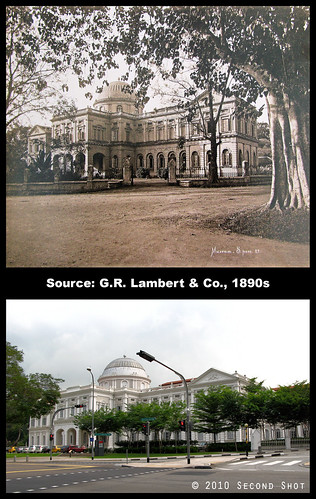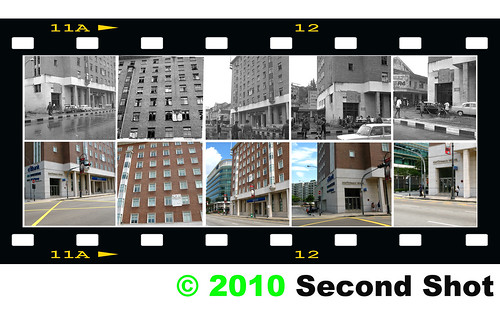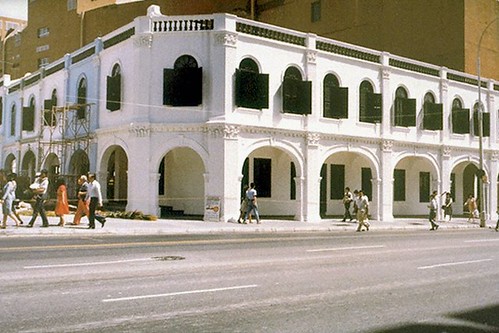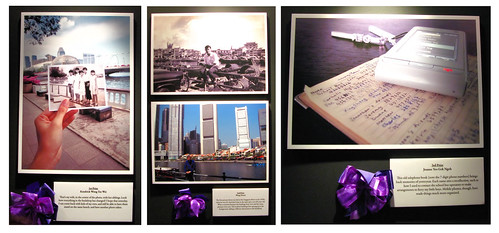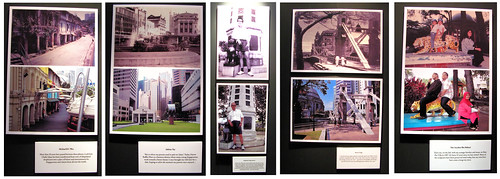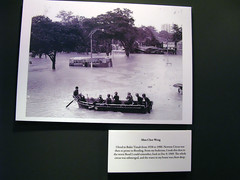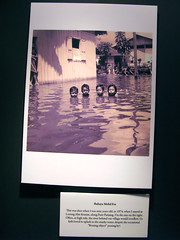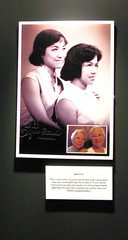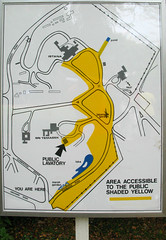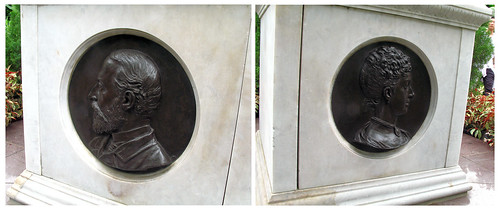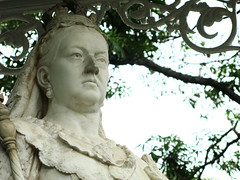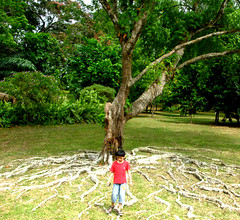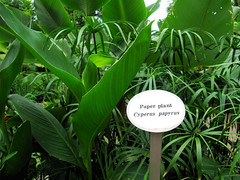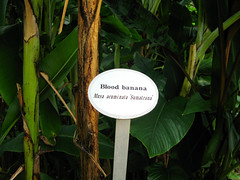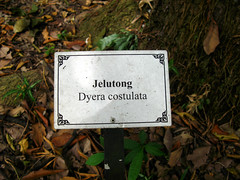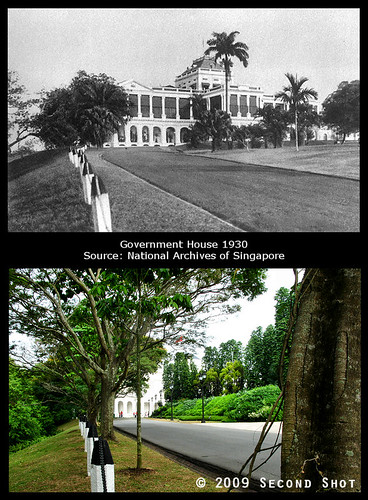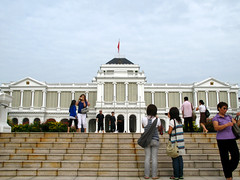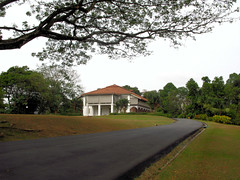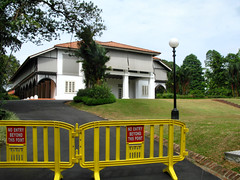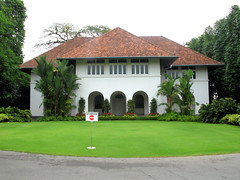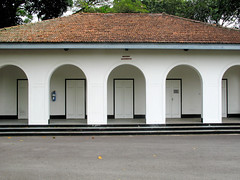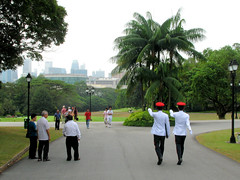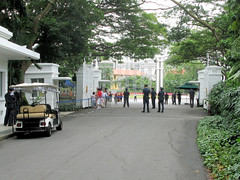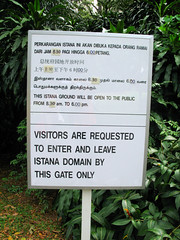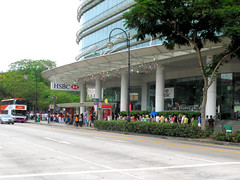Pages
Showing posts with label Orchard. Show all posts
Showing posts with label Orchard. Show all posts
Jan 19, 2013
A Very Short History of Plaza Singapura
Posted by
Icemoon
Last weekend we made a special trip to Plaza Singapura to check out its recently completed wing which I came to know from a friend's Facebook update. We met up with her friends over lunch, and I was introduced to the Swedish husband of her friend. A short tour of the new wing ensued ... so it is a small extension after all. I was more excited to head to the basement to check out the fate of the Carrefour shop space in the post-Carrefour era. A store I had forgotten the location if not for her reminder (hmm, I didn't realize all the while Carrefour was so near the entrance). For those with similar concerns, you can see from the photo Cold Storage is taking over the space.
Feb 28, 2012
How the Fort Canning Tunnel Altered our Road Landscape
Posted by
Icemoon
If we do a poll on the most detested and ugliest structure in town among heritage lovers, I suspect the honor would go to this tunnel through Fort Canning Hill. That time I checked out Orchard Presbyterian Church to investigate the 1984 curry murder, I saw its exit at Penang Road for the first time since it opened in 2007. I was momentarily at a loss for words staring at this edifice. Just as surprised would be the ancient kings of Temasek who could not have imagined a tunnel cutting right into their sacred Bukit Larangan.
Oct 23, 2011
End of An Era for Borders
Posted by
Icemoon
Borders is dead. I thought I just have to see it for myself at Orchard. Outside the covered walkway of Wheelock Place, I stared in disbelief at the slab panels, once transparent, now covered, the familiar sight of bookshelves and folks engrossed in their reading ... gone! Inside the mall, the grand entrance was not to be found. As I gazed at the shutters in its place, I wondered out loud - is this for real?
Aug 20, 2011
When Indian Curry was a Recipe for Murder
Posted by
Icemoon
In what was apparently a dispute seven years ago between a PRC family and their Singaporean Indian neighbour over the cooking of curry, some netizens rose to the occasion and organized a 'Cook A Pot of Curry' event on Facebook to share our love of curry with foreigners. Ostentatiously an international gastronomic drive in the name of multiculturalism, it was perceived in some quarters as being overly xenophobic. To my horror, as many as 55,000 people pledged, at least on paper (facebook that is), to cook/buy/eat curry this Sunday. Will the Community Mediation Centre be forced to work overtime in the upcoming weeks?
Jul 20, 2010
2nd Shot: Where's the tree outside National Museum?
Posted by
Icemoon
For over a century, the National Museum stand guard at the junction of Stamford and Orchard Road and bear witness to the changes in her surrounding. While geography has not changed - the building sitting at the foot of Fort Canning Hill and embraced by the gentle downslope curl of Fort Canning Road - a significant landmark visible in the old photo has gone missing.
Mar 10, 2010
2nd Shot: The MacDonald House Bombing, 45 Years Later
Posted by
Icemoon
March 10 is the 45th anniversary of the MacDonald House Bombing. In our Singapore annals of terrorism this attack is the worst, claiming three innocent civilian lives and injuring even more people. Windows were shattered, cars were damaged; MacDonald House itself suffered $250,000 in bomb damage. For most post-65er, the bombing remains our only impression of Konfrontasi. My other impression is that some of our fathers were drafted into the vigilante corps to "beat the rats" (or something like that). The more I read about the incident in textbooks and articles, the more I am intrigued about one aspect of the account - where exactly did the bomb explode?
Nov 7, 2009
2nd Shot: Emerald Hill to Pavilion Cinema
Posted by
Icemoon
Peter Chan asked if I would like to take a second shot from the middle of bustling Orchard Road. I gladly took up the challenge.
Oct 21, 2009
Rediscovering the Secret Tunnel under Orchard Road
Posted by
Icemoon
Thanks to all who commented, I have finally unravelled the mystery of the secret tunnel. The evidence has became indisputable, with multiple photos and eyewitness account. Because Second Shot is not Second Shot without the ground research, I took a trip down Orchard Road to see for myself the tunnel.
Sep 30, 2009
A Secret Tunnel under Orchard Road?
Posted by
Icemoon
I was at Orchard Road doing heritage research when I came across the notice. It was a total surprise as I did not know of a "pedestrian underpass connecting Specialist Shopping Centre to Centrepoint Shopping Centre".
Sep 14, 2009
2nd Shot: Peranakan Place at Orchard Road
Posted by
Icemoon
Peter was kind enough to share with me a 1948 photo of Orchard Road at the junction with Emerald Hill Road. Following his suggestion that I do a 'then and now', I made a trip to Orchard on a Sunday morning. I suppose this is one 'mission' oldies like Chun See, Peter, Victor or YG will loathe to undertake.
Foreground shows an itinerant fruit hawker, an interesting sight for me because I've read about roaming hawkers of yesteryear selling Laksa and Nasi Kandar but not fruits. I see pears, bananas, cut watermelons and what I think is a chopping board on the pushcart. I wonder whether the cut watermelons are plastic-wrapped like today.
Background shows the original double-storey shophouses dating back to 1902 that would become, through URA restoration, Peranakan Place in 1985. A pity the 'now' version is too heavily decorated with banners and a sidewalk cafe occupies what was once Emerald Hill Road. So I searched and found the following from the archives. Peranakan Place in her stark naked form:
The restored facade can be seen clearly and note the facade in the 1948 photo is very similar (other than the roof). You can see on the Emerald Hill side, the third and fourth porticoes (sorry, what's the proper architectural term for that structure along the walkway?) are higher than the first three. I love such nitty-gritty details.
The archive photo should be dated around 1985. You can see Centrepoint Shopping Centre (opened 1983) in the background. By then, bus lanes had been introduced.
Foreground shows an itinerant fruit hawker, an interesting sight for me because I've read about roaming hawkers of yesteryear selling Laksa and Nasi Kandar but not fruits. I see pears, bananas, cut watermelons and what I think is a chopping board on the pushcart. I wonder whether the cut watermelons are plastic-wrapped like today.
Background shows the original double-storey shophouses dating back to 1902 that would become, through URA restoration, Peranakan Place in 1985. A pity the 'now' version is too heavily decorated with banners and a sidewalk cafe occupies what was once Emerald Hill Road. So I searched and found the following from the archives. Peranakan Place in her stark naked form:
The restored facade can be seen clearly and note the facade in the 1948 photo is very similar (other than the roof). You can see on the Emerald Hill side, the third and fourth porticoes (sorry, what's the proper architectural term for that structure along the walkway?) are higher than the first three. I love such nitty-gritty details.
The archive photo should be dated around 1985. You can see Centrepoint Shopping Centre (opened 1983) in the background. By then, bus lanes had been introduced.
Aug 16, 2009
Second Shot @ Orchard Central: Then & Now Photo Exhibition
Posted by
Icemoon
I visited Orchard Central on Saturday to check out this new shopping mall as well as the "My Life: Then & Now" photo exhibition organized by TODAY newspaper. The 50 best entries were showcased, out of over 900.
Here is the contest:

Here are the top three entries:
I must say the grand winner is really creative in his choice of presentation. I read in the news he is a designer. He is Kendrick Wong and goes by the nick redmonsoon in cyberspace. You can read his flickr here and how he composed the winning shot here. Congratulations Kendrick!
Here are the 'second shot' related entries, not in order of merit:
Here is one photo I find outstanding because of its historical value. It shows a flooded Newton Circus in 1969. How many can recognize the place if this is a quiz? :)
Here is another one, showing a flooded rural area in Pasir Panjang. A flood brings inconvenience (see above) but somehow these kids enjoyed themselves! From the contestant - Us kids loved to splash in the murky water, despite the occasional "floating objects" passing by. Eh, I hope the floating objects are at most animal carcasses and not human corpses. (Update: this received a special mention during the National Day Rally)
Here is one I find cute. From two pretty ladies, we now have two old fogies. I guess they are now attractive in other ways - like their storytelling abilities and culinary skills.
These and other entries are available for public viewing in the Today gallery. But the gallery, broken up into 24 pages, takes a while to load even the thumbnails because the photos are preloaded as well. I've compiled all 24 pages into 1 mosaic so it is now easier to view all the thumbnails. Find a photo you like from the mosaic and go straight to the gallery page to download. I realize Mediacorp uses Silverlight for the gallery. Silverlight is a technology similar to Flash but because it is still not as pervasive as Flash, your browser may not have it and it will prompt you for installation.
The exhibition will run from Aug 9-21 at level one, Orchard Central. If you are interested, do note it is just inside the entrance from Killiney Road. Do not be like me - entered Orchard Central from Orchard Road entrance, searched high and low from 1st to 8th floor, then realized it is at the Killiney Road side entrance of 1st floor.
Jul 12, 2009
My Search for Queen Victoria in the Istana
Posted by
Icemoon
Visiting the Istana can be a fun-filled activity if you know what to do. Sure, you can ogle at fellow visitors and when the worm is caught, walk out triumphantly and jeer at the crowd still waiting to get in. Or you can play treasure hunt, the historical kind, where you go around uncovering hidden gems on the Istana grounds. I think the latter is more fun.
I have blogged about my second shot attempts (here and here) during the Chinese New Year Open House. I have also blogged about my failure to find the original nutmeg trees on the Istana grounds. This time round, I will blog about my search for royalty in the Istana. Will I succeed?
It is good to read up on the Istana before your visit. After all, you only get a few shots at it every year. Sure, you can ogle at the swans or the fountain, though I think there are much better ones around elsewhere. I found an enticing target from my research. She would be my prized catch in the Istana.
I call her The Queen, a statue of Queen Victoria on the Istana grounds. At 120 years old, she has seen her fair share of adventure and hardship. She used to stand comfortably in the alcove of the State Room (then called Victoria Room) until the 1960s when she was moved to the Victoria Memorial Hall and subsequently to the National Museum store. The various shifts over the years caused her great distress. When she resurfaced in 1994, she was found to have sustained injuries on her body, including her nose.
1953 archive photo of the Queen in the alcove of the State Room. I think it was Open House, that explains the kids.
Open House map of the Istana. I finally found The Queen at the pond on top at one o' clock position.
As you can see from the map, The Queen is found not far from the Istana building. She is at the edge of the area accessible to the public. You can see a lot of 'no entry beyond this point' sign in the Istana.
As I treaded my way to The Queen, a sight of what is to come greeted me - threebeauty queens women posing with 'style' and unknowingly for my camera. The rubenesque woman on the right caught my attention.
Left: The three queens posing with style. The rubenesque woman on the right reminds me of Queen Victoria.
Right: A portrait of Queen Victoria.
Left: The pond marked on the Istana Open House map.
Right: Queen Victoria is just behind the pond.
When you reach the end of the pond, Her Majesty awaits you. As you stand in awe, do not forget to pay your compliments.
Left: A visitor standing in awe of Her Majesty.
Right: The photographer paying homage to Her Majesty. Long live the Queen!
So here is Queen Victoria who used to stand comfortably in the alcove of the State Room. Today with the pavilion roof over her, she is still subjected to the wind element. The roof isn't going to help against our torrential rainstorm either.
The Queen taken from a similar angle as the 1953 archive photo earlier in the blog.
Earlier I described The Queen as 120 years old. If Queen Victoria is still alive today, she would be a whopping 190 years old. Coincidentally this year is the 190th anniversary of British founding of Singapore, so Queen Victoria was born in the year Singapore was founded.
At the base of the statue, we have a clue to the age of The Queen.
Gist: The Queen was presented by the Chinese community of Singapore to be placed in the Government House.
Surprisingly the statue was not a memorial by Her Majesty's 'ang moh' subjects but the Chinese community of Singapore. Did the Chinese community love Queen Victoria last time, considering it was a largely immigrant society from China and the reign of Her Majesty saw the lowest point of Anglo-Chinese relationship. Think the two Opium Wars and the plundering of Chinese imperial treasures by the English. I suspect the Chinese community refers to English-speaking Straits Chinese in the government service. The average coolie on the street probably did not know of the statue's existence.
The base inscription tells us the statue was presented in the year of Her Majesty's Jubilee. This was the Golden Jubilee of 1887, though the inscription was marked in the year 1888 and the Istana website refers to the Jubilee Year as 1889. I'm confused frankly, but the discrepancy does not change the fact The Queen is a Supercentenarian.
I also found two portraits at the base of the statue.
Are the portraits Queen Victoria and her husband Prince Albert?
I'm guessing they must be people dear to Queen Victoria. One possibility could be Victoria and her husband Albert but when you consider both were born in the same year (1819) and the portrait shows an old bearded man with a young attractive lady, the hypothesis weakens. Another possibility could be a son and daughter of the couple. Unfortunately I have no way to verify either hypothesis.
Finally, here is a close-up of The Queen. There is something incongruous about her face ....
Did The Queen knock her nose? Sign of her injury can still be seen.
Earlier I mentioned The Queen sustained injuries over the years. One particular spot was her nose. So here we have a statue of Her Britannic Majesty, ruler of an Empire on which the sun never sets, with her injured nose not properly restored.
I have blogged about my second shot attempts (here and here) during the Chinese New Year Open House. I have also blogged about my failure to find the original nutmeg trees on the Istana grounds. This time round, I will blog about my search for royalty in the Istana. Will I succeed?
**********
It is good to read up on the Istana before your visit. After all, you only get a few shots at it every year. Sure, you can ogle at the swans or the fountain, though I think there are much better ones around elsewhere. I found an enticing target from my research. She would be my prized catch in the Istana.
I call her The Queen, a statue of Queen Victoria on the Istana grounds. At 120 years old, she has seen her fair share of adventure and hardship. She used to stand comfortably in the alcove of the State Room (then called Victoria Room) until the 1960s when she was moved to the Victoria Memorial Hall and subsequently to the National Museum store. The various shifts over the years caused her great distress. When she resurfaced in 1994, she was found to have sustained injuries on her body, including her nose.
1953 archive photo of the Queen in the alcove of the State Room. I think it was Open House, that explains the kids.
Open House map of the Istana. I finally found The Queen at the pond on top at one o' clock position.
As you can see from the map, The Queen is found not far from the Istana building. She is at the edge of the area accessible to the public. You can see a lot of 'no entry beyond this point' sign in the Istana.
As I treaded my way to The Queen, a sight of what is to come greeted me - three
Left: The three queens posing with style. The rubenesque woman on the right reminds me of Queen Victoria.
Right: A portrait of Queen Victoria.
Left: The pond marked on the Istana Open House map.
Right: Queen Victoria is just behind the pond.
When you reach the end of the pond, Her Majesty awaits you. As you stand in awe, do not forget to pay your compliments.
Left: A visitor standing in awe of Her Majesty.
Right: The photographer paying homage to Her Majesty. Long live the Queen!
So here is Queen Victoria who used to stand comfortably in the alcove of the State Room. Today with the pavilion roof over her, she is still subjected to the wind element. The roof isn't going to help against our torrential rainstorm either.
The Queen taken from a similar angle as the 1953 archive photo earlier in the blog.
Earlier I described The Queen as 120 years old. If Queen Victoria is still alive today, she would be a whopping 190 years old. Coincidentally this year is the 190th anniversary of British founding of Singapore, so Queen Victoria was born in the year Singapore was founded.
At the base of the statue, we have a clue to the age of The Queen.
Gist: The Queen was presented by the Chinese community of Singapore to be placed in the Government House.
Surprisingly the statue was not a memorial by Her Majesty's 'ang moh' subjects but the Chinese community of Singapore. Did the Chinese community love Queen Victoria last time, considering it was a largely immigrant society from China and the reign of Her Majesty saw the lowest point of Anglo-Chinese relationship. Think the two Opium Wars and the plundering of Chinese imperial treasures by the English. I suspect the Chinese community refers to English-speaking Straits Chinese in the government service. The average coolie on the street probably did not know of the statue's existence.
The base inscription tells us the statue was presented in the year of Her Majesty's Jubilee. This was the Golden Jubilee of 1887, though the inscription was marked in the year 1888 and the Istana website refers to the Jubilee Year as 1889. I'm confused frankly, but the discrepancy does not change the fact The Queen is a Supercentenarian.
I also found two portraits at the base of the statue.
Are the portraits Queen Victoria and her husband Prince Albert?
I'm guessing they must be people dear to Queen Victoria. One possibility could be Victoria and her husband Albert but when you consider both were born in the same year (1819) and the portrait shows an old bearded man with a young attractive lady, the hypothesis weakens. Another possibility could be a son and daughter of the couple. Unfortunately I have no way to verify either hypothesis.
Finally, here is a close-up of The Queen. There is something incongruous about her face ....
Did The Queen knock her nose? Sign of her injury can still be seen.
Earlier I mentioned The Queen sustained injuries over the years. One particular spot was her nose. So here we have a statue of Her Britannic Majesty, ruler of an Empire on which the sun never sets, with her injured nose not properly restored.
Note: The two mystery portraits are that of the Prince and Princess of Wales, the Queen's eldest son and his wife. Thanks Job Ang!
Apr 18, 2009
Istana Open House 2009: Help! I can't find the Nutmeg Tree
Posted by
Icemoon
I have previously blogged about my experience at the Istana Open House earlier this year. I took second shots (here and here), covered a bit of history and had a field day admiring the crowd waiting to enter the Istana. I did not get to shake the President’s hand unfortunately, because I was the early bird and according to Victor, the President only comes out during sunset.
There was another purpose for my visit and that was to find the nutmeg trees that once graced the land which became the Istana Domain.
According to history, 100 acres of land belonging to Charles Prinsep’'s nutmeg plantation was bought over for the construction of Government House. And according to the Istana website,
I did not manage to find my nutmeg tree (or clove tree) in the end. But my flora search revealed some interesting plants.
Paper Plant.
It was a surprise to find the Cyperus papyrus – Paper plant - in Singapore. I knew the ancient Egyptians used some kind of plant to make papyrus paper, but I didn’t know you can find it in Singapore. Today, the plant is cultivated not for paper but for ornamental purposes. In fact it is nearly extinct in its native habitat in the Nile Delta.
Blood Banana
A blood-stained yellow fruit? The Blood Banana is named for the dark red patches on its leaves (photo from far). The plant is ornamental and I read that its small fruit is “theoretically edible like any banana”, according to this wikipedia entry.
Jelutong
Jelutong is a tree grown commercially for timber. I read here that it can be tapped for latex as well. In the past, Jelutong latex was an important source of chewing gum.
So I did not find my nutmeg tree. What a pity because such a tree may be a descendant or even a member of the original Prinsep plantation. If yg were there, he would be able to recognize one. In fact, he blogged about the few nutmeg trees in Lim Chu Kang. I think nutmeg trees are quite uncommon in Singapore.
There was another purpose for my visit and that was to find the nutmeg trees that once graced the land which became the Istana Domain.
According to history, 100 acres of land belonging to Charles Prinsep’'s nutmeg plantation was bought over for the construction of Government House. And according to the Istana website,
I was optimistic …. even though I can’t tell a nutmeg tree from a clove tree.
A few nutmeg trees still grow in the grounds of the Istana. Clove and nutmeg trees in this part of the grounds recall the original Prinsep plantation.
I did not manage to find my nutmeg tree (or clove tree) in the end. But my flora search revealed some interesting plants.
Paper Plant.
It was a surprise to find the Cyperus papyrus – Paper plant - in Singapore. I knew the ancient Egyptians used some kind of plant to make papyrus paper, but I didn’t know you can find it in Singapore. Today, the plant is cultivated not for paper but for ornamental purposes. In fact it is nearly extinct in its native habitat in the Nile Delta.
Blood Banana
A blood-stained yellow fruit? The Blood Banana is named for the dark red patches on its leaves (photo from far). The plant is ornamental and I read that its small fruit is “theoretically edible like any banana”, according to this wikipedia entry.
Jelutong
Jelutong is a tree grown commercially for timber. I read here that it can be tapped for latex as well. In the past, Jelutong latex was an important source of chewing gum.
So I did not find my nutmeg tree. What a pity because such a tree may be a descendant or even a member of the original Prinsep plantation. If yg were there, he would be able to recognize one. In fact, he blogged about the few nutmeg trees in Lim Chu Kang. I think nutmeg trees are quite uncommon in Singapore.
Feb 22, 2009
2nd Shot: Istana Domain and Government House 1920
Posted by
Icemoon
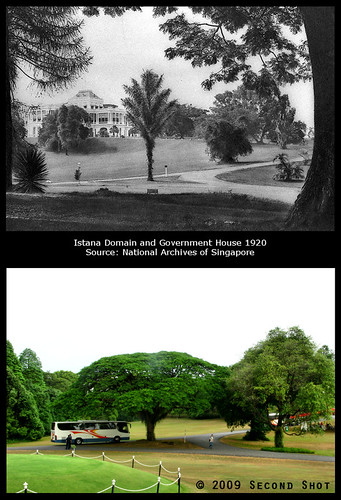
I had great fun during Istana Open House 2009. One of my activities was to capture the Second Shot above. As a first-time visitor to the Istana, I did not know the location, only that the Istana is in the background. Luckily my first Second Shot location was on top of a slope and I reckoned it is the same slope in the artefact from 1920 (above).
A Second Shot in the Istana is challenging. You battle it out with the terrain (due to my own ineptitude at navigation), the largely non-Singaporean crowd and of course …. the police. Check out the Istana map. The distinctive fork-road is visible on the centre of the map. To the south, where the photo was taken, the area is not accessible to the public. I was standing on forbidden ground.
Little wonder the man in blue kept on looking at my general direction. I must have
The continuous monitoring was making me uneasy. Besides, I was not supposed to be on publicly inaccessible ground. My next Second Shot target was thus dropped.
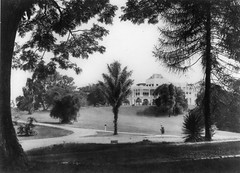 Source: National Archives of Singapore. I would have got this by moving to the left of my initial position. Of course, by this time, the men-in-blue would have pounced on me from all directions.
Source: National Archives of Singapore. I would have got this by moving to the left of my initial position. Of course, by this time, the men-in-blue would have pounced on me from all directions.By the way, can anybody recognize whether the same tree is in my Second Shot? I am referring to both trees at the centre. I doubt they are even of the same species.
(Edit: There is something strange about my unattempted Second Shot target above. Can you spot it? Turns out I was wrong about the location, i.e. I wouldn't have got it even if I moved to the left of my initial position. Luckily I never tried - the men-in-blue would have still pounced on me, so much for risking my life to take an impossible Second Shot. Thanks to my friend Johnny for spotting it.)
Feb 9, 2009
2nd Shot: Government House 1930
Posted by
Icemoon
Photo taken during Istana Open House 2009. Made a beeline for the spot once inside the Istana Domain.
This was my first time in the Istana. It was fun trying to locate the places from old photographs – consider that my orientation. The search for old Istana photos constituted the bulk of my research. The research into Istana’s history was done after the trip.
Feb 2, 2009
Istana Open House 2009: A Palace and the Splendour of Temasek
Posted by
Icemoon
My reason for visiting the Istana was twofold. After years of repeating the happy-new-year-where-is-my-red-packet regime, I decided it was time for a change. Moreover the Open House provided a rare chance for a glimpse inside the sprawling garden that is the official residence of the President of Singapore. What is the Istana? Just as our President trounces the US President in salary, the Istana triumphs the White House in acres. Does the President need such a big house?
The Istana was born on 1867. The year should ring a bell if you were an attentive history student like Yours Truly (I can even remember that momentous page in my history textbook which shows the governor seated with his council). On April Fool’s Day the same year, the Straits Settlements comprising Singapore, Malacca and Penang became a Crown Colony, taking orders directly from the Colonial Office in London instead of the Governor-General of India. The Governor, in office since February, was promoted in stature if not in position. He could nowstop listening to bullshit from British India have more autonomy. As a Crown Colony, the Governor was assisted by the Executive and Legislative Councils.
The governor was Sir Harry Ord and the Istana, his brainchild. The Istana was meant to be his residence. The first governor’s residence was on Bukit Larangan, i.e. Fort Canning, built after the founding by Raffles but demolished in 1859. A governor was too important to be made homeless, so arrangements were made for leased housing on Grange Hill and later Leonie Hill. But as Harry tried to show - even before HDB - home ownership is important.
So the dissatisfied Harry acquired 106 acres of land from Charles Prinsep’s nutmeg plantation and ordered a proper Government House be built. The design was finalised in March and the foundation stone laid (by Lady Ord) in July 1867. But Harry was not without his detractors. Some of his colleagues thought he was too extravagant. To pull out real figures, the initial building fund was at $100,000. The final sum amounted to $185,000. The Istana was completed in 1869.
Shoot and be shot (by my camera). The Open House saw many visitors whipping out their cameras. Many were posing for the camera so I just conveniently shot them. For example, here and here. They look pretty unsingaporean.
Locals were the minority during the Open House. Young ladies like these make my day and they might not be locals. There is no foolproof way to identify a local unless they “open their golden mouth” (金口一开).
To the south of the Istana lies a two-storey detached house also built in 1869. Called Sri Temasek – Splendour of Temasek – it was the residence of the Colonial Secretary. I’m not sure of its genesis, whether the Colonial Secretary ordered it built or because the Governor and his Second Man should live close together.
In any case, Sri Temasek is the official residence of the Prime Minister of Singapore. But just like the Istana, no Prime Minister ever lived inside as their home. In fact it was not used for many years and fell into disrepair, finally undergoing restoration between 2006 and 2008. The 2008 National Day message was delivered there.
So, unlike the US President, ours do not stay in a ‘White House’. (Edit: My friend Johnny told me a very simple reason for this - US presidents typically stay in another state while ours just stay in another estate) Perhaps no succeeding presidents after Yusof Ishak wanted to ‘spoil market’. Or perhaps like Harry, they believe in home ownership (governors last time were rightly, expatriates; they returned to Britain after their term or took up position in other colonies. Our presidents are all citizens and they are deeply rooted in Singapore.). Or perhaps both buildings are symbols of opulence, good for ceremonies and entertaining foreign guests, but no president should ever stay in a palace (Istana is Malay for palace).
Today, the Istana houses the office of the President and the Prime Minister. The latter (Prime Minister’s Office, PMO) is in the Istana Annex.
No access to Sri Temasek during Open House. Luckily there was a public lavatory nearby and this was as close I could get. The previous photo of Sri Temasek and its picturesque lawn was taken from non-public area, with a men-in-blue staring from afar.
Visitors will walk past a house on the way to the Istana. Called the Istana Villa, it was built in 1938. Not the residence of the President or Prime Minister, maybe for the butler? Just joking, I really do not know its purpose. It could be used to house foreign heads of state, a guesthouse?
Sri Temasek and Istana Villa were out of bounds during the Open House. Men-in-blue were stationed inconspicuously nearby to stop any unauthorised access.
This is the military guardroom of the Istana. It could be used by the sentries at the Istana Main Entrance. SAF Provost Unit supplies one unit of 20 guards monthly to perform ceremonial guard duties at the Istana.
Hastily snapped this outside the guardroom. They were probably relieving the two sentries at the main gate. Photo was taken at 1016, so when are guards supposed to relieve duties?
Genesis of a Palace
The Istana was born on 1867. The year should ring a bell if you were an attentive history student like Yours Truly (I can even remember that momentous page in my history textbook which shows the governor seated with his council). On April Fool’s Day the same year, the Straits Settlements comprising Singapore, Malacca and Penang became a Crown Colony, taking orders directly from the Colonial Office in London instead of the Governor-General of India. The Governor, in office since February, was promoted in stature if not in position. He could now
The governor was Sir Harry Ord and the Istana, his brainchild. The Istana was meant to be his residence. The first governor’s residence was on Bukit Larangan, i.e. Fort Canning, built after the founding by Raffles but demolished in 1859. A governor was too important to be made homeless, so arrangements were made for leased housing on Grange Hill and later Leonie Hill. But as Harry tried to show - even before HDB - home ownership is important.
So the dissatisfied Harry acquired 106 acres of land from Charles Prinsep’s nutmeg plantation and ordered a proper Government House be built. The design was finalised in March and the foundation stone laid (by Lady Ord) in July 1867. But Harry was not without his detractors. Some of his colleagues thought he was too extravagant. To pull out real figures, the initial building fund was at $100,000. The final sum amounted to $185,000. The Istana was completed in 1869.
Shoot and be shot (by my camera). The Open House saw many visitors whipping out their cameras. Many were posing for the camera so I just conveniently shot them. For example, here and here. They look pretty unsingaporean.
Locals were the minority during the Open House. Young ladies like these make my day and they might not be locals. There is no foolproof way to identify a local unless they “open their golden mouth” (金口一开).
Look! A giant in front of the Istana.
Glory of Temasek for the Second Man
To the south of the Istana lies a two-storey detached house also built in 1869. Called Sri Temasek – Splendour of Temasek – it was the residence of the Colonial Secretary. I’m not sure of its genesis, whether the Colonial Secretary ordered it built or because the Governor and his Second Man should live close together.
In any case, Sri Temasek is the official residence of the Prime Minister of Singapore. But just like the Istana, no Prime Minister ever lived inside as their home. In fact it was not used for many years and fell into disrepair, finally undergoing restoration between 2006 and 2008. The 2008 National Day message was delivered there.
So, unlike the US President, ours do not stay in a ‘White House’. (Edit: My friend Johnny told me a very simple reason for this - US presidents typically stay in another state while ours just stay in another estate) Perhaps no succeeding presidents after Yusof Ishak wanted to ‘spoil market’. Or perhaps like Harry, they believe in home ownership (governors last time were rightly, expatriates; they returned to Britain after their term or took up position in other colonies. Our presidents are all citizens and they are deeply rooted in Singapore.). Or perhaps both buildings are symbols of opulence, good for ceremonies and entertaining foreign guests, but no president should ever stay in a palace (Istana is Malay for palace).
Today, the Istana houses the office of the President and the Prime Minister. The latter (Prime Minister’s Office, PMO) is in the Istana Annex.
No access to Sri Temasek during Open House. Luckily there was a public lavatory nearby and this was as close I could get. The previous photo of Sri Temasek and its picturesque lawn was taken from non-public area, with a men-in-blue staring from afar.
The Villa, for Whom?
Visitors will walk past a house on the way to the Istana. Called the Istana Villa, it was built in 1938. Not the residence of the President or Prime Minister, maybe for the butler? Just joking, I really do not know its purpose. It could be used to house foreign heads of state, a guesthouse?
Sri Temasek and Istana Villa were out of bounds during the Open House. Men-in-blue were stationed inconspicuously nearby to stop any unauthorised access.
Military Guardroom for the Guards?
This is the military guardroom of the Istana. It could be used by the sentries at the Istana Main Entrance. SAF Provost Unit supplies one unit of 20 guards monthly to perform ceremonial guard duties at the Istana.
Hastily snapped this outside the guardroom. They were probably relieving the two sentries at the main gate. Photo was taken at 1016, so when are guards supposed to relieve duties?
Jan 29, 2009
Istana Open House 2009: How the Early Bird Catches the Worm
Posted by
Icemoon
After years of following the same routine, I decided to try something new to break the monotony of Chinese New Year. This 初二 (second day of the lunar new month), I visited the Istana during its annual open house.
Usually closed to the public, the Istana grounds are open on five occasions – Chinese New Year, Deepavali, Hari Raya Puasa, Labour Day and National Day. Admission is free for citizens and permanent residents. Foreigners pay an entrance fee of $1 per person. For the first time in months, I feel proud to be a citizen.
The plan was to reach the Istana before its opening at 0830. However, the night before, back from Chinese New Year celebration, I was still finishing up my research and sending them for printing. As a result, I slept a little late and thanks to the nice weather, I got up at the time I should be on the road.
I arrived at the Istana Gate a little after 0900. There a queue – less than 10 people – had formed in front of a small booth. A lady volunteer was gesticulating to the approaching visitors, “citizens and permanent residents this side”, referring to her left (my right). Apparently the booth was a ticket booth and, as a citizen, I could skip it. However I couldn’t help but notice there were more people at the booth than skipping it. It was an ominous sign.
A male volunteer stood at the gate. I knew the ritual. Out came the pink card; I didn’t even stop for him. Up to this point, the card appeared to have magical powers. It was exhilarating too when a fellow civilian – not a police – checked your card.
Past the gate, another ritual greeted me. This should be no surprise. I laid my bag onto the conveyor belt and crossed the gate. Luckily, it did not beep.
Istana Main Gate at 0914. They have hidden the tentage for the second ritual behind the gate, to the left of the photo, away from public sight.
Notice and map after the main gate. The map shows you the public areas (shaded) and forbidden areas (presumably what’s not shaded). Looking at the sheer number of Men in Blue in the previous photo standing idly behind the main gate, do you expect any less in the Istana Domain?
I had great fun inside the Istana Domain, doing what I do best and trying not to get caught.
Two hours later, I decided I had enoughof the voices that sounded so unsingaporean.
At 1130 I was out and WOW WHAT A SIGHT!
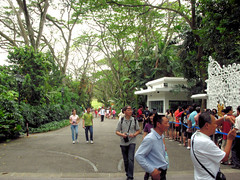
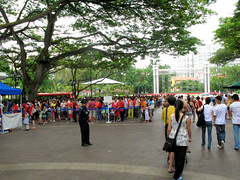
Left photo shows the queue waiting for their second ritual behind the gate. Right photo shows the queue outside the main gate. Remember the queue was less than 10 originally?
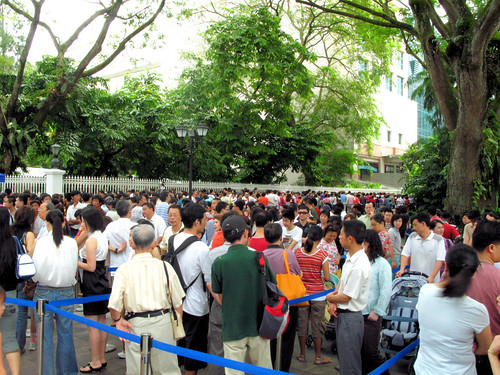
The human snake outside the main gate. The last stretch must be the most demoralising. From just outside the gate, the queue turns right, all the way to Plaza Singapura before making a U-turn back to the gate.
I captured the whole spectacle from Istana Park across the road. The crowd outside was beyond my expectation. There was this indescribable feeling - I was finished, ready to go home and these people were still queuing under the midday sun. Should I pity themor laugh at their stupidity? It feels good to be an early bird, doesn't it?
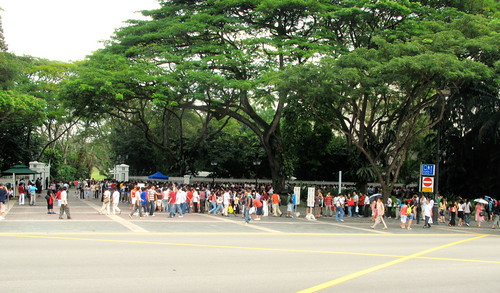
The spectacle from across the road. If you want to laugh, better do it here, away from the crowd.
Do you know how long the queue was? See below.
The Atrium@Orchard. You have to admire those who are last in the queue. Last in the game, but never lose sight of their goal.
Judging from the crowd, the Open House was overly successful. You have people who are dying to shake Nathan’s hand (I did not meet the President inside) and you have people – like me – who are curious about what’s inside. Or maybe it is the cheapest way to ‘escape the New Year’ (闭年).
Usually closed to the public, the Istana grounds are open on five occasions – Chinese New Year, Deepavali, Hari Raya Puasa, Labour Day and National Day. Admission is free for citizens and permanent residents. Foreigners pay an entrance fee of $1 per person. For the first time in months, I feel proud to be a citizen.
The plan was to reach the Istana before its opening at 0830. However, the night before, back from Chinese New Year celebration, I was still finishing up my research and sending them for printing. As a result, I slept a little late and thanks to the nice weather, I got up at the time I should be on the road.
I arrived at the Istana Gate a little after 0900. There a queue – less than 10 people – had formed in front of a small booth. A lady volunteer was gesticulating to the approaching visitors, “citizens and permanent residents this side”, referring to her left (my right). Apparently the booth was a ticket booth and, as a citizen, I could skip it. However I couldn’t help but notice there were more people at the booth than skipping it. It was an ominous sign.
A male volunteer stood at the gate. I knew the ritual. Out came the pink card; I didn’t even stop for him. Up to this point, the card appeared to have magical powers. It was exhilarating too when a fellow civilian – not a police – checked your card.
Past the gate, another ritual greeted me. This should be no surprise. I laid my bag onto the conveyor belt and crossed the gate. Luckily, it did not beep.
Istana Main Gate at 0914. They have hidden the tentage for the second ritual behind the gate, to the left of the photo, away from public sight.
Notice and map after the main gate. The map shows you the public areas (shaded) and forbidden areas (presumably what’s not shaded). Looking at the sheer number of Men in Blue in the previous photo standing idly behind the main gate, do you expect any less in the Istana Domain?
I had great fun inside the Istana Domain, doing what I do best and trying not to get caught.
Two hours later, I decided I had enough
At 1130 I was out and WOW WHAT A SIGHT!


Left photo shows the queue waiting for their second ritual behind the gate. Right photo shows the queue outside the main gate. Remember the queue was less than 10 originally?

The human snake outside the main gate. The last stretch must be the most demoralising. From just outside the gate, the queue turns right, all the way to Plaza Singapura before making a U-turn back to the gate.
I captured the whole spectacle from Istana Park across the road. The crowd outside was beyond my expectation. There was this indescribable feeling - I was finished, ready to go home and these people were still queuing under the midday sun. Should I pity them

The spectacle from across the road. If you want to laugh, better do it here, away from the crowd.
Do you know how long the queue was? See below.
The Atrium@Orchard. You have to admire those who are last in the queue. Last in the game, but never lose sight of their goal.
Judging from the crowd, the Open House was overly successful. You have people who are dying to shake Nathan’s hand (I did not meet the President inside) and you have people – like me – who are curious about what’s inside. Or maybe it is the cheapest way to ‘escape the New Year’ (闭年).









